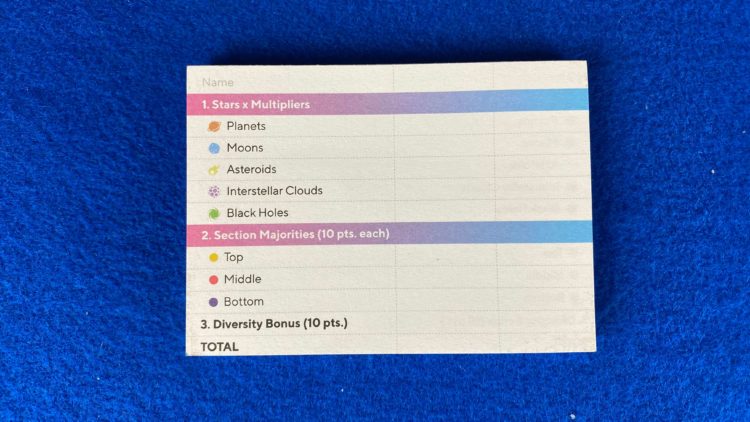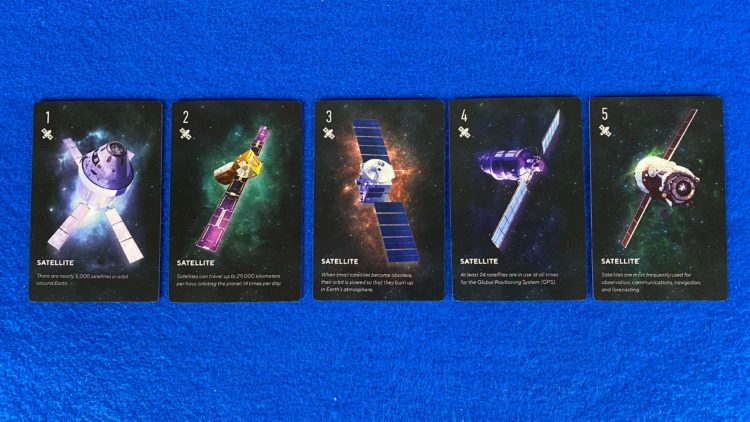
OBJECTIVE OF STELLAR: Be the player with the highest score at the end of the game
NUMBER OF PLAYERS: 2 players
MATERIALS: 89 playing cards, 1 scorepad, 2 reference cards
TYPE OF GAME: Card game
AUDIENCE: Adults
INTRODUCTION OF STELLAR
Stellar is a commercial card game for 2 players. It was published by Renegade Game Studios in 2020. Stellar is a tableau building card game that challenges players to build the most valuable array of cards possible. In this game, players will have to carefully place cards from five different types on their telescope tableau. The player that can create the most combinations, play the most valuable cards, and create the most diversity in their tableau will win the game.
MATERIALS
Stellar contains many different cards and components for gameplay.
60 CELESTIAL OBJECT CARDS

There are six types of celestial object cards including planets, black holes, interstellar clouds, asteroids, and moons. There are also satellite cards discussed further down. Each card, aside from satellites, has a card value, a star value, and an interesting fact.
24 TELESCOPE CARDS

There are two sets of telescope cards. These form the grid that players will play cards upon.
5 NUMBER CARDS

The number cards are used to mark different slots in the card row.
1 SCOREPAD

The scorepad helps keeping score simple.
2 REFERENCE CARDS

These handy reference cards will keep the players on track.
SETUP

Each player should start with their 12 telescope cards arranged to form the telescope picture.
The space on the table below the telescope picture is called the notebook. Shuffle the five starter celestial object cards (noted with a diamond in the bottom corner) and deal two of them to each player. The player decides which card will begin face up at the top of their telescope, and which one will be placed face up in their notebook.
Take the fifth starter celestial object card and shuffle it in with the rest of the celestial object card deck. Each player is dealt two cards from this deck. The rest are placed face down as a draw pile. Lay out the five numbered cards in a row and deal one celestial object card under each of them. Also, give each player one reference card.
THE PLAY
Stellar is played over eleven rounds. During each turn, players will play cards in such a way to build the highest valued display on their telescope. Points will be accrued based on card value and placement. Each turn consists of four phases.
ADD A CARD
The first player begins their turn by choosing one card from the numbered card row and adding it to their hand.
PLAY A HAND CARD
The player then chooses a card from their hand and plays it to their telescope or their notebook. The card’s number will determine which card can be played on the next phase of the turn.
PLAY A ROW CARD
Next, the player must play the celestial object card from the row card number that matches the card they just played from their hand. This card is played to an area that the player did not just play a card to. If the player just played a card to the telescope, the numbered row card must be played in the notebook.
For example, if the player played a number 3 planet card from their hand to the telescope, they must play the card sitting in the number 3 row section to the notebook. If the row section is empty, play the top card from the celestial object draw pile.
REFILL THE ROW
Refill empty slots in the numbered row with cards from the celestial object draw pile. This ends the turn.
THE TELESCOPE
The telescope is composed of twelve different cards. Each card represents a space where a celestial object card can be played. A space is no longer available for play once it has been filled with a card.
The telescope has three sections: the top contains the top five cards, the middle contains the row of three cards, and the bottom contains a row of four cards. Each section is scored differently.
When playing cards to the telescope, special rules must be followed. When playing a type of card that has already been added to the telescope, the new card must be added to a spot adjacent to the card of the same type. The edges of the cards must touch. If that card type has not yet been played, it can be placed in any open space.
If a player is unable to add a card to the telescope, they must play a card face down in the slot. This card automatically has the number value 3, but it does not have a type or star value.
THE NOTEBOOK
The notebook also has its own rules that must be followed. Players will add a card to their notebook each turn. One stack for each card type will be collected in the notebooks. As cards are collected and played in the notebook, they should be arranged in sequential order and staggered so their card number can be seen. The player should have a separate stack for each of the five card types.
It is possible for stacks to have copies of the same card. The copies will not score any points.
SPECIAL CARDS
There are two types of special cards in this game.
6/0 CARDS

Each card type has its own 6/0 cards. When it is played on the telescop, it is always a 6. If the 6/0 is played first, the player must draw from the celestial object deck to play their second card.
If the 6/0 card is played to the notebook, it can count as a 6 or a 0 depending on the player’s preference. They do not have to decide until the end of the game.
SATELLITE CARDS

Satellite cards are wild. They have a card number of 2, and can be played on any open telescope space. Since they are wild, they can be any card type the player needs them to be.
A satellite can be played to the notebook as well. When it is used in the notebook, it can be any card type the player needs it to be. It can also be moved from pile to pile as needed until the end of the game.
When a satellite card is chosen from the numbered row slot, the opposite player can choose to remove all other celestial object cards from the numbered row and refill the row with new ones. Those cards can be shuffled and used as part of the draw pile later.
SCORING
At the completion of the eleventh round, the game is over. Players choose one card from their hand to add to their notebooks, and the last remaining card is discarded.
STARS & MULTIPLIER SCORE
The following scoring process will be completed for each celestial object card type:
- Choose one of the five card types to begin.
- Look at the telescope and add up the total number of stars for each card in that type.
- Find that card type in your notebook.
- Count up how many cards in that pile are in consecutive order.
- Multiply those two numbers together.
- Do this for each card type and add the numbers together.
TELESCOPE SECTION BONUS
- In each section of the telescope, add together the card numbers.
- The player with the highest total in that section earns 10 bonus points.
- If there is a tie, neither player earns bonus points.
- Add the telescope section bonus points to the score from above.
DIVERSITY BONUS
- If a player has at least one card of each type in their telescope, they earn a 10 point bonus. Face down cards and satellites do not contribute to this.
- If earned, add this bonus to the total from the above two sections.
WINNING
After tallying up the scores, the player with the highest total wins. Ties are not broken.
- TRIPLE SNAKES - February 15, 2021